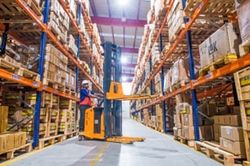Sufferance Warehouse (CBSA)
| This article is part of the Customs Glossary Guide |

A Sufferance Warehouse is a temporary storage facility approved by the Canada Border Services Agency (CBSA). Importers, carriers, and freight forwarders use Sufferance Warehouses to store goods that have arrived in Canada but have not yet been released by customs authorities. This article defines the concept of a Sufferance Warehouse, explores its usage scenarios, and outlines its significant role in the efficient importation of shipments to Canada.
What is a Sufferance Warehouse?
A Sufferance Warehouse is a licensed facility designed to temporarily store imported goods that have not yet been granted customs clearance by the CBSA. These warehouses provide a secure location for holding shipments while importers or their representatives complete the necessary customs documentation and payment of duties and taxes. Sufferance Warehouses play a crucial role in facilitating the movement of goods across borders and ensuring the smooth processing of imports into Canada.
Usage Scenarios of Sufferance Warehouse:
Delayed Customs Clearance:
Scenario: A shipment of electronics arrives at a Canadian port but lacks certain required documentation for customs clearance. Sufferance Warehouse Usage: The carrier or importer may choose to place the goods in a Sufferance Warehouse until the necessary documentation is provided, and the customs clearance process is completed.
Incomplete or Incorrect Paperwork:
Scenario: A shipment of perishable food items has arrived, but the commercial invoice contains discrepancies that need to be resolved. Sufferance Warehouse Usage: To prevent spoilage, the goods are temporarily stored in a Sufferance Warehouse while the importer rectifies the paperwork and complies with customs requirements.
Controlled Goods and Inspections:
Scenario: A shipment contains goods subject to specific regulations and requires thorough inspection by CBSA officials. Sufferance Warehouse Usage: The goods are placed in a Sufferance Warehouse to facilitate CBSA inspections and ensure compliance with all applicable laws and regulations.
Role of Sufferance Warehouse in Importing Shipments to Canada:
Customs Compliance and Facilitation:
Sufferance Warehouses play a vital role in ensuring that imported goods comply with Canadian customs regulations. They provide a controlled environment where shipments can be held until all customs formalities, duties, and taxes are properly addressed.
Secure and Temporary Storage:
By offering secure storage facilities, Sufferance Warehouses protect imported goods from loss, damage, or theft during the period between arrival and customs clearance. This ensures the integrity of the supply chain and preserves the value of the merchandise.
Supporting Trade Flow Efficiency:
Sufferance Warehouses contribute to the efficient movement of goods across borders. They prevent congested ports by allowing carriers to unload shipments promptly, even when some clearance procedures are pending.
Compliance Verification:
The use of Sufferance Warehouses enables CBSA to verify the accuracy and authenticity of shipment documentation and provides a controlled setting for inspections, protecting Canadian borders from potential risks associated with non-compliant or hazardous shipments.
Conclusion
Sufferance Warehouses are instrumental in the smooth importation of goods into Canada. Acting as temporary storage facilities approved by the CBSA, they play a crucial role in ensuring customs compliance, secure storage, and efficient trade flow. By utilizing Sufferance Warehouses, importers, carriers, and freight forwarders can navigate customs clearance procedures more effectively, promoting the timely and secure movement of goods across Canadian borders.
